
 Antenna Modeling Programs as Teaching Tools
Antenna Modeling Programs as Teaching ToolsAt the Novice and Tech level, antenna questions are few, but cover a surprisingly sophisticated array of concepts. Most students have little choice other than to commit correct answers to memory. Those who want to know more, however, can fix in mind a number of important ideas abetted with a well-guided tour of one of the numerous antenna modeling programs now available.
Here are some advantages of using an antenna modeling program:
1. Economic availability: Antenna modeling programs are available at a very reasonable cost, given their long term benefits. Of course, the program owner can also use it to good purpose outside the classroom. At this level, it does not matter whether the teacher chooses a version of MININEC or of NEC-2: both are more than adequate to the task of vividly guiding students through some basic ideas.
Programs useful for teaching are available from three main sources. For DOS machines are ELNEC (MININEC) and EZNEC (NEC-2), available from Roy Lewallen, W7EL, P.O. Box 6658, Beaverton, OR 97007. Also for DOS are AO (MININEC plus an antenna optimizer) and NEC Wires (NEC-2), available from Brian Beezley, K6STI, 3532 Linda Vista, San Marcos, CA 92069. For Windows users, there is NEC-Win Basic (NEC-2) from Paragon Technology, Inc., 200 Innovation Blvd., Suite 240, State College, PA 16803. Program prices range from about $50 to under $100, a bargain for what you get.
2. Dynamic instruction: Antenna modeling programs are dynamic. Basic concepts can be taught statically, using chalkboard, models, and various graphics. However, antenna modeling programs permit the instructor to guide the student through some basic comparisons, overlaying one pattern on another. They also permit real variation of antenna variables, such as dipole length, to connect real wire dimensions to real consequences. Students can ask questions about variations on an instructional model and watch their variations yield results.
3. Small group instruction: The programs, being PC-based, encourage small group instruction. Four or five students gathered around the instructor create a good learning environment. When numbers are small, students tend to ask more questions than they do in large classes. They feel freer to offer comments that reveal how well they do or do not understand the ideas involved. Responses can be tailored to individual needs. Of course, the instructor may need to repeat the procedure in order to serve everyone in class, but he or she will discover that no two sessions are alike, a pleasing challenge for most teachers.
4. Scripting: Antenna modeling programs permit careful scripting of the guided tour. All programs permit the user to save each antenna model as a separate small file. The instructor can organize a progression of files by names or numbers. In class he or she can then keep track of what comes next with a simple list of topics and filenames.
Of course, it also pays to have on hand a number of supplementary models designed to anticipate probable student questions. Constructing a good model of even such a basic antenna as a 2-meter quarter-wave vertical with a sloping set of ground plane radials can take a good bit of time. Preplanning keeps the class running smoothly. However, every class will likely add new models to the list of supplements.
Even experienced lesson plan writers who organize teaching material by expert second nature should not expect to purchase a program and instantly use it in the classroom. Antenna modeling programs need to be mastered carefully. They contain numerous variables that surround the situation of an antenna, and the user must learn how to set them and the best values to use. Modeling the antenna itself requires mastery of the program's key words, such as "wire," "segment," "source," and "load," and what each means to a good antenna model. If using a three axis coordinate system (X, Y, Z) for antenna dimensions is unfamiliar, it will require practice to handle smoothly. If elevation and azimuth patterns are not second nature, they will require some study so that the instructor can select the relevant patterns and speak about them usefully.
All of these (and other) preparation steps take a bit of time. Fortunately, the manuals that accompany antenna modeling programs are quite detailed and thorough. Additionally, all of the listed programs provide the user with premodeled antennas to familiarize him or her with modeling conventions and practices. For a bit of initial guidance, you might look at the following item: "A Beginner's Guide to Using Computer Antenna Modelling Programs," The Antenna Compendium, Vol. 3 (Newington: ARRL, 1992), pp. 148-155; reprinted in Vertical Antenna Classics, ed. R. Schetgen (Newington: ARRL, 1995), pp. 10-17.
Bring some model antennas to the session, including a ground plane vertical, a dipole, a 2-element Yagi, and a 3-element Yagi. You can make miniature models from wire, wood dowels, and the like. Their purpose is both visual identification and orientation to what the antenna modeling patterns show.
Using the miniature models, orient the students to the ideas of elevation pattern and azimuth pattern by having them look down the ends of the horizontal antennas and then from above. You will also need the miniatures later to demonstrate what it means to look at an azimuth pattern at an angle above horizontal and to look at patterns of antennas that are vertically and horizontally polarized.
For these exercises, it is likely best to keep all models over real ground rather than trying to explain the difference between free space and real ground. Students will be more intuitively familiar with antennas a certain height above ground.
1. 80-Meter Dipole: A #14 wire dipole for 3.7 MHz about 50' above real ground makes a good starting exercise. You can begin by showing them the model file with the wires (about 62.3' each side of center). Since the angle of highest radiation for this low dipole (relative to a wavelength at 80 meters) is straight up, preset the azimuth pattern angle at about 45 degrees Make this model as resonant as you can, hopefully with a feedpoint reactance under 1 Ohm.
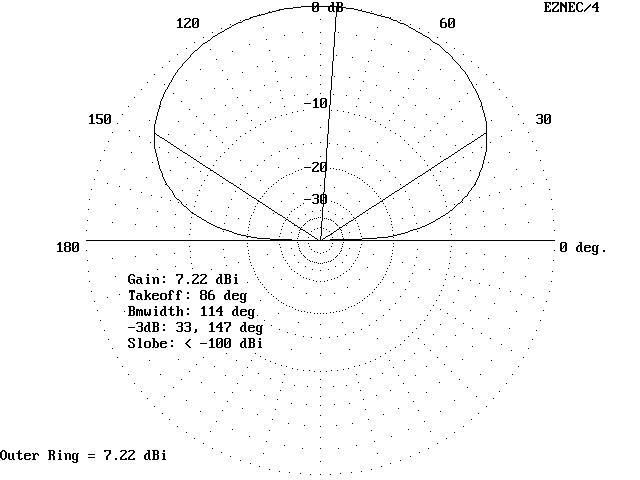
There are three major items this model can illustrate. a. By showing students the elevation pattern, you can explain what a pattern shows, namely, that at some distant points (but not skip distance), the signal strength would be the same at each point along the perimeter of the pattern. This is a measure of the strength of the radiated field in the transmit mode and the sensitivity of the antenna to received signals. You can also explain that because the antenna is so low in height compared to the length of a wave (80 meters long), much of its energy is radiated straight upward, but with plenty going off at angles for good ham communications.
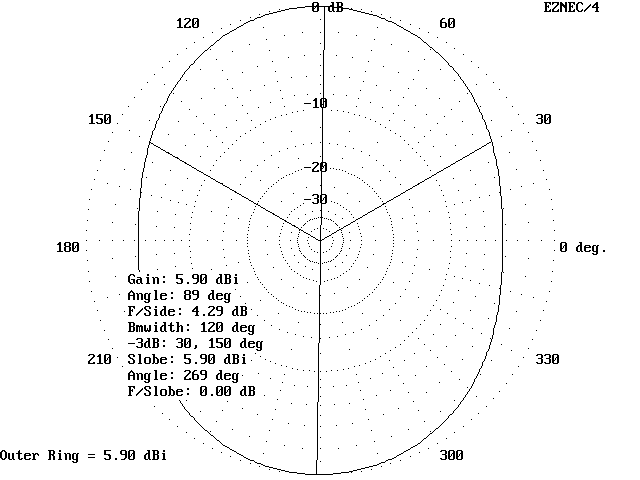
b. Next you can show them the azimuth pattern at 45 degrees upward. Not only will this verify that there is good energy for communications, but as well, it will show that the classic figure-8 pattern of a dipole applies only to antennas with greater height relative to a wavelength.
c. Show the students the feedpoint conditions report, including the feedpoint impedance and the SWR. Even though the books place the resonance impedance of a straight dipole at 70-72 Ohms, our low antenna shows an impedance of 57-58 Ohms resistive. Now note the good match to standard 50-Ohm coax with an SWR of about 1.15:1.
This is a good opportunity to introduce the student to how to refine his or her own antenna. Construct a second version of this model lengthened so that it shows about a 2:1 SWR at 3.7 MHz. 64.9' each side of center should do the trick. Construct a third model of the antenna shortened to achieve the same 2:1 SWR; 62.3' will be quite close. Again, sow the student each model and the feedpoint report, noting the inductive (+) reactance for the long model and the capacitive (-) reactance for the short one.
If the student has only an SWR meter to make measurements, he or she cannot initially tell from a 2:1 SWR that the antenna is too long or to short. Typical advice to new antenna builders includes finding the lowest SWR point for the antenna. You can use the long and short models to make this point more real to students. The short antenna will show resonance (less than 1ê reactance) at about 3.775 MHz, while the long antenna will resonate at about 3.625 MHz. Obviously, we lengthen the short one and prune the long one, but not to the model dimensions. Instead, we strive with simple antennas for lowest SWR at or near the frequency we want to call the design center.
One final note: you can also compare the gain numbers. It is not important whether you use dBi or dBd. Here, it is important for the student to note that the SWR figures do not significantly change the gain of the antenna at all. Make sure they do not get caught up in any numbers past the first two digits, even though programs often give more decimal places. And be sure they understand that a difference of one decimal place is operationally meaningless.
2. Dipoles and Yagis: Because the programs permit you to save and then overlay various patterns developed by the numerical analysis, it becomes convenient to demonstrate to students the basic principles of gain. Perhaps 10 meters is the best place to perform this comparison, since this is a band for both dipoles and Yagis.
Start by bring on screen the pattern of a typical dipole, a little over 16' long. Use the azimuth pattern at the proper take-off angle. If you place the dipole about 30-35' up in the air over real ground, students can see that, compared to the 80-meter dipole, the classic figure-8 pattern is reappearing because the antenna is now closer to a full wavelength up in the air.
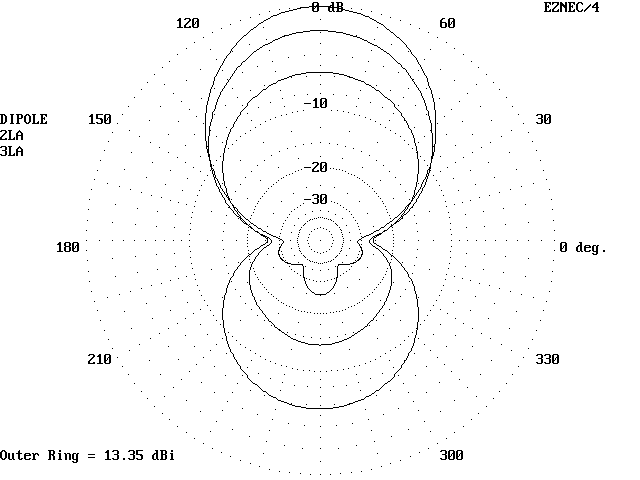
Now call up the pattern of a 2-element Yagi that you have previously saved and let it overlay the dipole pattern. Having a miniature physical model on hand and orienting it in the same plane as the miniature dipole will let you bypass any steps needed to show the antenna on screen and thus let you go straight to the azimuth pattern. Again, use the same antenna height above ground and the proper take-off angle.
You are now in a position to show students the modest, but real gain of the Yagi over a dipole, as well as demonstrating the basic idea of front-to-back ratio as an aid in reducing QRM. Teach them also to scan the entire rear lobe of the antenna to note its shape and the relative QRM reduction from all rear quadrants (what some call the front-to-rear ratio). When counting the grid layout rings, labeled in dB, remember that a full S- unit on the student's receiver will be about 6 dB.
If your program permits, add a third pattern from your saved files, this time for a 3-element Yagi. Again, use a physical miniature to orient the students to the antenna. Students should instantly note the further, but small increase in gain. However, they should also note the more significant increase in Front-to-back ratio and the improvement in the overall front-to-rear ratio. Well designed Yagis, and their models, should show another S-unit of improvement in rear rejection.
You should also stress that the humble dipole begins with good gain over real ground. For all the advertising claims and impression left by the claims, the dipole remains a good antenna for making excellent contacts across the country and world. Directional antennas like the Yagi are helpful in many ways, but they are not absolutely necessary for enjoying amateur radio.
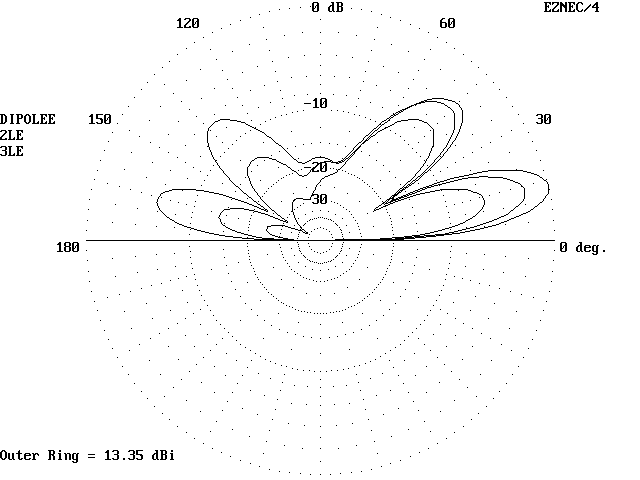
Unless students have specific questions about the feedpoint conditions, you should avoid burdening them with the numbers associated with the Yagis. The lower numbers require that one use a matching system, an advanced topic. If the student buys a beam, the manufacturer will explain the tune-up procedure for that system. Is a student wants to build a beam, you can give that individual a little one-on-one instruction on the side.
3. A 40-15 Dipole: A misconception many students pick up is that if they use a dipole, it must have something like the figure-8 pattern. A little exercise with a 40-meter dipole can correct that impression very quickly. The first step is to construct a model of a 40-meter dipole, perhaps 50' high. Make it a little long, perhaps 68.8' long with #14 copper wire. At 7.1 MHz, show the azimuth pattern at about 39 degrees take-off angle. The very oval shaped 80-meter dipole pattern for an antenna at the same height in feet is now just beginning to pinch in its sides, since the antenna is twice as high relative to a full wavelength at its frequency.
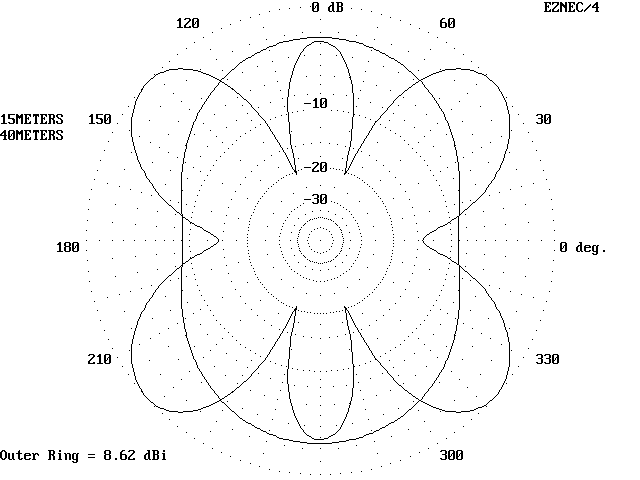
Next, simply change the frequency to about 21.2 MHz, on the pretext of showing them that a 40-meter dipole can be used at 15 MHz also. Let the 6- petal pattern emerge. You can then explain that an antenna's pattern depends in part on how long the antenna is relative to the length of a radio wave. If they prefer the figure-8 pattern, they will have to construct a half-wave dipole specifically for 15 meters. If they are interested, you might use the miniature antennas to add some practical notes on orienting the antenna so that maximum radiation goes in the most desirable directions. In my part of the country (TN), running the wire North-South gives good 40-meter coverage East and West, while placing the strongest 15-meter lobes on some of the best DX paths.
These simple active exercises have introduced students to concepts they need to understand to pass the license test. In addition, they have enabled some very practical instruction on the side. That aspect of the instruction makes the test questions far more meaningful to the student. Once you start the process of developing models for class, you will discover many more useful workouts with models.
4. Quarter-wave and 5/8ths-wave Verticals: Although handheld 2-meter rigs use rubber duck antennas, the student may wish to use an outdoor antenna at home. Some version of a ground-plane vertical will likely be the first choice, perhaps atop a 25' roof peak. It is fairly easy to model a 146 MHz version of such an antenna with 4 radials. Make the radials about 20.2" long each on a flat plane and the radiator about 20.05" straight up, all using #12 copper wire. This is a ground plane the student can actually build.
First show the students an azimuth pattern (take-off angle about 3ø) to confirm that they understand that vertical antennas provide a uniform pattern of radiation in all directions (unless interrupted by nearby objects). Then switch to an elevation pattern. The elevated vertical antenna provides a certain signal strength in its lowest lobe. Just for reference, have the students record the gain figure for the antenna (about 5.4 dBi or 3.3 dBd).
Also call attention to the complex pattern of upper lobes. Caused by interactions between the basic (incident) radiation of the vertical and reflections from the ground plane, these lobes are hardly ever useful at VHF for repeater work. Finally, call attention to the feedpoint report, noting the low feedpoint impedance and SWR (a little greater than 2:1). Have students record this with the gain number.
Next, start a new model, this time a 5/8ths wavelength vertical. Using the same ground plane, simply extend the length of the vertical element to about 45 inches. Go through the same steps, first verifying the uniform azimuth pattern and then showing an elevation pattern. Students have heard that 5/8th wavelength antennas are supposed to have a theoretical gain over a quarter-wave vertical of about 3 dB. Hence, they may be surprised to learn that with such a simple ground plane, they are unlikely to achieve more than something over a half dB of gain.
Finally, show them the feedpoint condition report. If they have wondered why 5/8th wavelength antennas have a little tapped coil at the base, they can at least partially understand why. The base coil is a matching circuit to permit the use of 50-Ohm coax with the complex impedance of the longer antenna.
As a final exercise in the series, return to a quarter-wave vertical with its 4 ground plane radials, all of #12 copper wire 25' high. In the model, bend the radials down 45 degrees. You can use the Pythagorean theorem to calculate the outer end coordinates (about 14.3" out and the same down). The shift in ground plane position will require that you shorten the vertical whip to about 18.67" long. This should resonate close to 146 MHz.
You may wish to start the run of this model with the feedpoint conditions report. Compare the results with the flat ground plane model. The sloping ground plane yields a very good match for 50-ohm coax--so close that any difference does not make a difference. If a home-made antenna is not a perfect match, the student can always add more or take away from the bend of the radials to perfect the match.
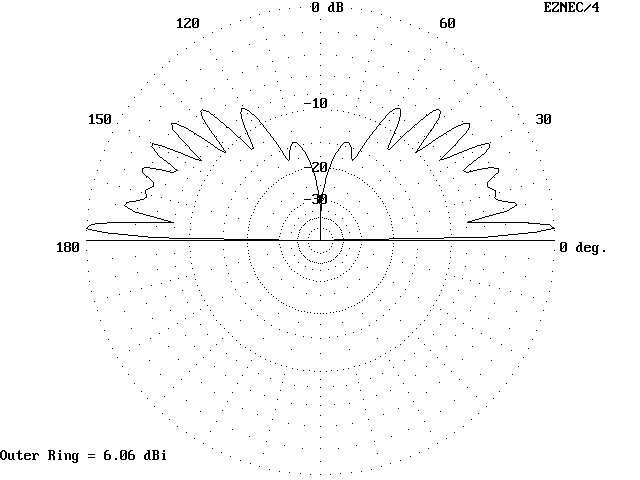
If students trust by now that the vertical radiates uniformly in all horizontal directions, go straight to an elevation pattern. While all three elevation patterns have similar features, including the complex array of high lobes, this pattern shows a bit more gain than the flat plane quarter-wave vertical and perhaps an insignificant amount more than the model of the 5/8ths wavelength vertical.
If you wish the students to think about this situation, you might ask them how we could get more gain when we actually shortened the vertical whip by a tiny bit. The answer, of course, lies in the sloping ground plane elements. Now they operate not only as a ground plane, but as an approximation of a vertically oriented dipole. That is, the ground plane elements add to the radiation of the antenna. Hence, more power is radiated than with the flat plane quarter-wave vertical, whose ground plane added virtually nothing to the power radiated.
If any of these antennas is well matched to the feedline, it will perform quite well for the student. The gain differences are too small to make a practical difference. More significant differences emerge from changing the height of these antennas. At 6' off the ground, they all perform comparably to each other, but all at reduced gains, reductions that may make a difference in practical operations.
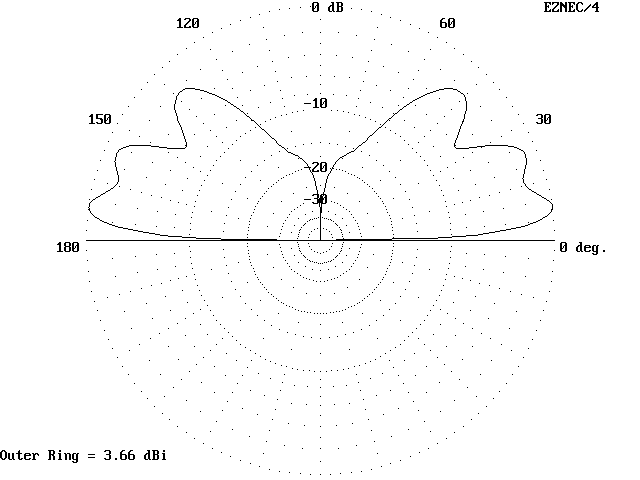
If you run this supplemental exercise, you will note that the 5/8ths wavelength vertical provides somewhat more gain than either of the other two models (but still under 1 dB). That little extra may account for the popularity of the 5/8ths wavelength antenna as a mobile antenna.
2. Horizontal and Vertical Yagis: Many students will be tempted early after receiving their licenses to put up a small beam for extended repeater coverage. From advertisements, they are perhaps used to seeing the azimuth patterns of horizontally polarized Yagis. However, they may be surprised by the azimuth pattern of a vertically polarized Yagi.
First, model a small, 3-element 2-meter Yagi. These dimensions, set for 146 MHz, may be useful to you:
Reflector length: 39.8"
Space: 18"
Driven Element length: 37.25"
Space: 14.5"
Director length: 33.4"
This compact beam has a front-to-back ratio around 20 dB, and its 40-Ohm feedpoint impedance matches well to short runs of coax. With half-inch diameter aluminum elements, it is a distinct candidate for homebrewing.
Construct the model for this beam in the horizontal plane. Bring up the azimuth pattern (4 degree take-off angle at a 25' height). From the HF exercises, students will recognize the typical Yagi pattern.
Next construct in advance the same beam oriented vertically. In class, simply overlay the pattern of the same beam at the same height (measured at the boom) in its new orientation. Now explain the "eyeball" pattern.
Miniatures are useful in helping students grasp why the pattern spreads, with slightly less gain. Horizontally, ground reflections strengthen the lowest lobe and create some high lobes (visible on an elevation pattern). The beamwidth is a function of the antenna's geometry of tapering element lengths. Vertically, the radiation that bounced off the ground in the horizontal mode now can spread to its fullest extent, for a beamwidth almost double the horizontal orientation. Only the weaker side (element end) radiation now reflects off the ground; hence, slightly less gain.
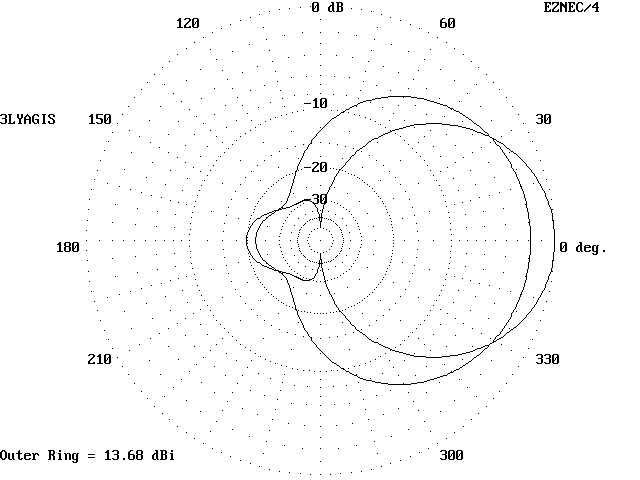
Operationally, these facts mean that a Yagi set up vertically for repeater and other FM work need not be moved as often to catch stations slightly off the beam's axis. Although the wider beamwidth of the vertical orientation may occasionally permit some QRM, the ease of finding a heading that permits full quieting operation on FM will usually outweigh the uncommon irritation.
Students are likely to notice that the beam offers very significant gain over a vertical. You should therefore remind them of the other costs involved in putting up a beam, including the need for a rotator. Get them from the start to think about how an antenna relates to the kind of operating they envision doing, and how the entire communications system fits into a budget. The models of beams may not only explain some basic concepts to students, but may also attract them. Part of the lesson should be to help the student put everything in perspective.
These sample exercises only scratch the surface of uses to which you may put an antenna modeling program in the classroom. I have purposely kept the samples close to the basic concepts students should master for the Novice and Tech licenses, along with some practical material so that they can have realistic expectations from their new stations.
However, there are many features of these programs which you may use to good advantage according to your plans and style of teaching. Most programs provide rotatable views of the antenna model for comparison with miniatures or full-size VHF antennas. Some programs provide 3-dimensional views of the far field radiation patterns as a webbing: use these with caution, since they can both clarify and confuse. In the program reporting systems, there lies a wealth of data, most of which is best saved for more advanced students.
Finally, there is the program itself. Some students will not be
satisfied merely watching the demonstrations. They will want to learn how
to use the program to understand other types of antennas and possibly one
day to design their own. You may find yourself staying after class to
teach a new generation of antenna modelers.
From Proceedings of the 1996 National ARRL Education Workshop, (Newington: ARRL, 1996), pp. 28-35 © L. B. Cebik, W4RNL. Data may be used for personal purposes, but may not be reproduced for publication in print or any other medium without permission of the author.